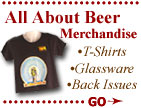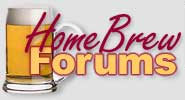
| ||||
| AAB Departments |
| ...Beer Features |
| ...Beer Talk |
| ...Pull Up A Stool! |
| ...What's Brewing |
| ...Beer Travelers |
| ...Stylistically Speaking |
| ...Beer & Food |
| ...Homebrewing |
| ...Collectibles |
| ...Marketplace |
| Beer Lovers' Resources |
| ...World Beer Festival |
| ...Brew Cruise Info |
| ...AAB Merchandise |
| ...AAB Bookstore |
| ...Beer Links |
| About the Magazine |
| ...Subscription Info |
| ...Retail the Magazine |
| ...Advertising Info |
| ...Contact AAB |

|
A gaggle of gadgets
(Most under $20)
OK, so Christmas, Chanukah and Kwanza are over and you didn't get that custom mega-bucko half-barrel brewery that you wanted for the basement. Not even one little stainless steel butterfly valve of it. Still, the brewing must go on. If you want to treat yourself to a little something to add a little new excitement to your brew days, consider these handy -- and generally economical -- ideas.
1. Siphon Starter - these devices help you get your racking tube filled with beer without committing the ultimate sin of sucking on the end. Two types, syringe or ball with one-way valves. Either way a good investment.
2. Strip Thermometer - These liquid crystal temperature indicators stick to the side of your fermenter or soda keg to give you a good indication of what the temperature is inside. Great way to monitor fermentations or check the temperature of beer before carbonation.
3. Kitchen Wizard - A kitchen calculator that gracefully converts between metric and American units (e.g.: cups to liters, ounces to grams, deg F to deg C) and calculates as well. In addition, it is useful for scaling recipes written in U.S. units. For instance, if you want to carbonate one gallon of beer, how much corn sugar should you add? The kitchen wizard will tell you that 1/5 of 3/4 of a cup equals about 2.4 tablespoons.
4. Malt/Hop Calculator Wheels - Dubbed "Doctor Bob Technical's Amazing Wheel of Beer" and "Doctor Bob Technical's Incredible Hop-Go-Round," these amazing little devices allow you to determine malt and hop quantities without the use of electricity. Both devices are designed like circular slide-rules (anybody remember what those are?) so that you can quickly specify several variables in order to determine the needed ingredient quantity.
5. Homebrew Color Guide - Anyone who is interested in a more accurate understanding of beer color should pickup this simple film-based color reader. By comparing the standards on the reader to the actual color of your beer in a standard plastic judging cup, you can determine your beer's color to within about 1 degree SRM. Useful anytime you evaluate beer whether homebrewed or commercial.
6. Stainless steel probe thermometer - If your initial homebrew setup included a floating glass thermometer, you've probably already figured out that it is pretty slow to adjust when you want to take a reading. Stainless steel probe thermometers react more quickly and they are practical for many applications where the larger glass model just won't do.
7. Carbonator top -
These devices can be charged with CO2 from a standard soda keg gas fitting and they quickly screw on the top of one-liter and two-liter plastic soda bottles. With one of these, you can inexpensively take a supply of homebrew to a party without having to worry about bringing home your empties.8. Long-neck lighter - Those with a Cajun cooker or other high-BTU outdoor burner may find it useful to keep this butane-fueled fire-starter close at hand. Available at most hardware stores, they allow you to ignite your burner with the pull of a trigger, while still keeping your hand away from the action.
9. Siphon spray or siphon aerator - These small devices fit on the exit end of your siphon tube to help you aerate your cool wort during transfer to the primary fermenter. One is a simple cone of plastic that spreads the wort into a wide spray pattern. The second provides a simple air opening on the side of the line so that air will be sucked in to mix with the passing wort.
10. Carbon Water Filter - A carbon filter provides that most basic function of water treatment, namely chlorine removal. Sure, there are other ways of doing it, but they require time and/or heat to achieve. For an instant supply of chlorine-free brewing water, attach one of these units to your brewing sink.
11. Brewing Books - You can't brew all the time, but you can immerse yourself in brewing whenever you want to by picking up a book. Beginning brewers can complete the classics that we have listed in our Recommended Reading section, while more experienced brewers can check out books on specific styles, recipe formulation or even the details of specific ingredients. Check out our bookstore or see your local retailer for suggestions. (Then you could always take a look at the latest addition to the brewing literature, called Designing Great Beers and written by the editor of a certain homebrew web page which you happen to be visiting!)
Here's wishing you good brewing in the new year.










